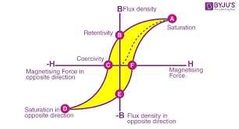![]()
![]()
![]()
Use LEFT and RIGHT arrow keys to navigate between flashcards;
Use UP and DOWN arrow keys to flip the card;
H to show hint;
A reads text to speech;
14 Cards in this Set
- Front
- Back
|
Formula for input power into a transformer |
IpVp |
|
|
Formula for output power from a transformer |
IsVs |
|
|
What is Eddy Currents? |
Due to variation in a magnetic flux eddy currents are induced on the surface and iron core which produces heat and therefore reduces the power to the secondary coil. |
|
|
How do you avoid Eddy Currents? |
In order to avoid Eddy Currents, the core is laminated, made of thin sheets of iron. Each sheet is separated from the next by a layer of insulating varnish. |
|
|
What is hysteresis loss? |
Each time the direction of magnetization is reversed some useful energy is wasted in covercoming the internal friction. |
|
|
How do you avoid hysteresis loss? |
Hysteresis loss is minimised by using special alloys known as "perm alloys" for core material |
|
|
Heating |
Some energy is dissipated as heat in the coil. |
|
|
Flux transport failure |
Some loss of useful energy occurs because a small amount of the flux associated with the primary coil to pass through the secondary. |
|
|
What is copper loss? |
Copper loss is energy dissipated by resistance in the wire used to wind a coil. |
|
|
Study the hysteresis loop diagram |

|
|
|
Turn ratio of a transformer |
n = Ns/Np |
|
|
Input and output voltage in transformer |
Ns/Np = Vs/Vp |
|
|
What does Ns and Np stand for |
Ns = # of windings on primary coil Np = # of windings on secondary coil |
|
|
Efficiency of a tranformer |
(VsIs/VpIp) x 100 |

